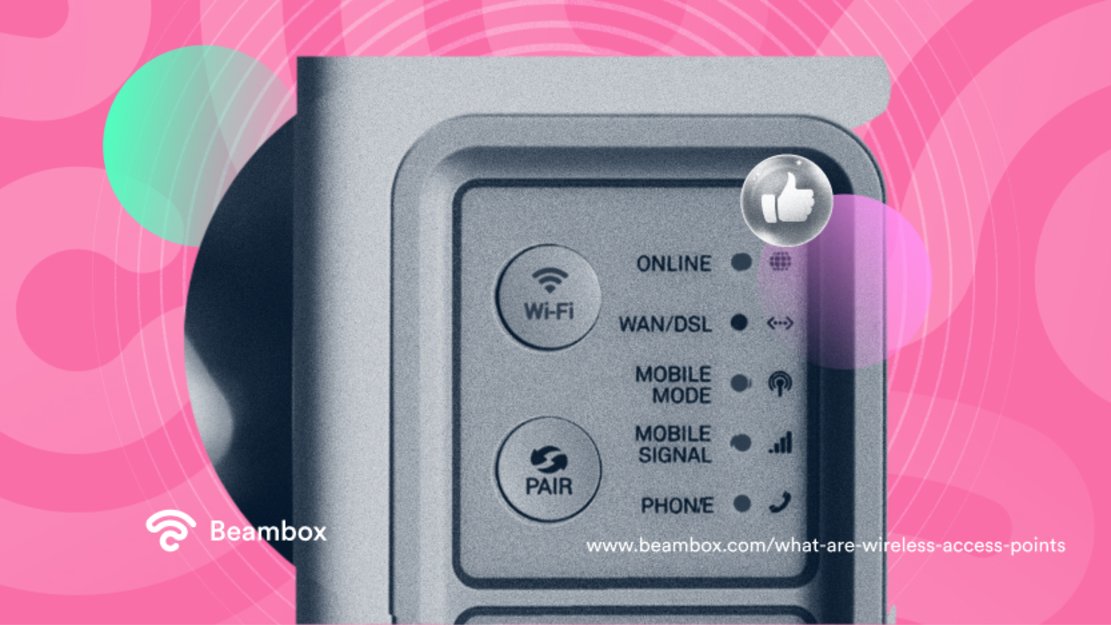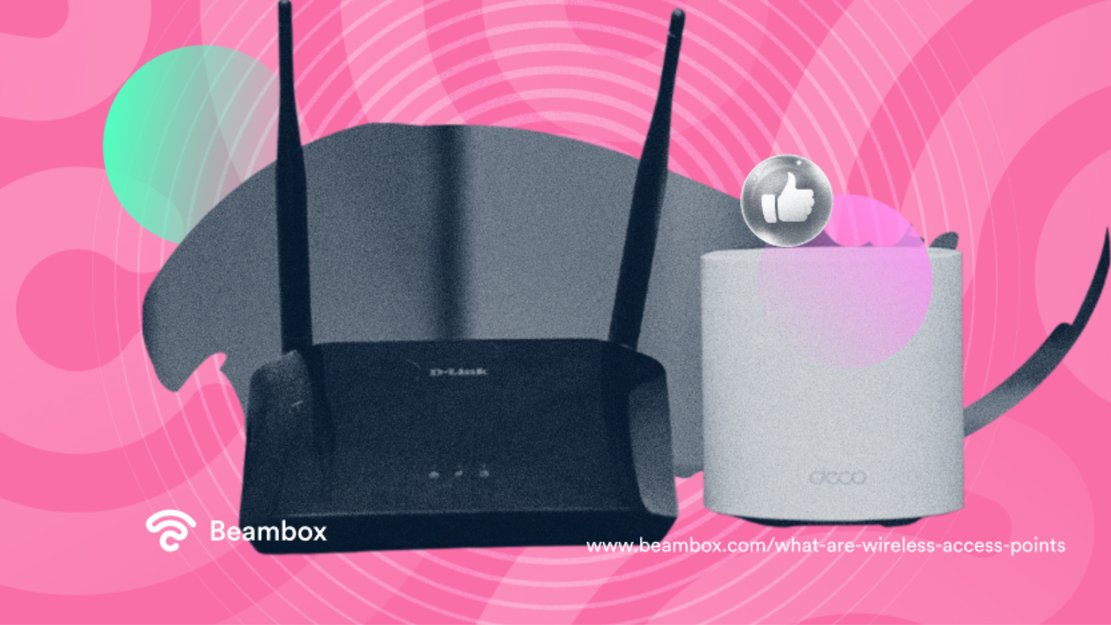In this age of constant connectivity, wireless access points are crucial to our daily lives. They are necessary for establishing connections to a wireless network, making it easy to access the internet. People use Wi-Fi 24/7 but have no clue how it functions. Many don’t care about the science behind wireless connections, whether they are wireless devices or cable networks. They only find out about it after facing poor connectivity, which forces them to do some digging. It leads to further confusing questions such as “What are wireless access points?”
This article aims to unravel this frequently asked question. This guide will provide a complete overview if you want to understand what is a wireless access point.
By the end of this article, you’ll understand Wi-Fi and wireless access points’ purposes, types, and differences. We’ll also delve into the benefits and disadvantages associated with their use.

What Are Wireless Access Points?
For easy understanding, it is better to break up this term into two separate parts: “wireless” and “access points.” Acquiring knowledge about them will make it a breeze to comprehend what are wireless access points.
- Wireless refers to the technology that allows devices to communicate without physical cables.
- Access points, on the other hand, make wireless communication possible between devices and a wired network. This is possible by creating a local area network.
Access points, on the other hand, make wireless communication possible between devices and a wired network. This is possible by creating a local area network.
So combining the two, wireless access points, also known as WAPs, serve as gateways, enabling devices to connect wirelessly to a network infrastructure. They facilitate communication between wireless devices and a wired network by serving as central hubs. WAPs seamlessly access network resources like the Internet by wirelessly transmitting and receiving data packets over wired networks.
Homes, offices, schools, and public areas frequently use wireless access points. They make it possible for devices to connect to a network without employing actual cables, giving them mobility and flexibility.

What Are Wireless Access Points Used For?
Now that you know wireless accounts points, it is important to understand its use in real-life. WAPS provides devices with wireless network connectivity. They deliver connections covering a large area. If you’re wondering, “What are wireless access points used for?” Here are some of the most common applications.
-
Creating a wireless network
Gone are the days of cable networks, which were a hassle due to the limitations of a wired connection. WAPs enable devices to connect to a wireless network, providing access to network resources and the internet. Utilizing it is especially beneficial in parks, stadiums, campuses, and other public areas where a wireless connection is a must.
-
Providing security
Wireless network security includes features like encryption conventions (e.g., WPA2, WPA3) and authentication methods. These security measures are a great source of protection from unauthorized access. The security features can restrict access for some individuals or prevent connections with some devices. Moreover, guest WiFi access can be set up with limited credentials, ensuring visitors cannot access sensitive information. Visitors connect to a separate network with restricted access, keeping the central network secure.
-
Long-range coverage and expansion
Multiple access points can expand the wireless network’s coverage area in larger environments. It is highly beneficial where a single WAP may not be adequate. Access points installed in strategic locations can guarantee consistent connectivity throughout a building or campus.
-
Mobility and roaming
What is a wireless access point mobility and roaming feature? The access point itself is exempt from mobility and roaming. WAPs facilitate seamless connectivity as users move within the coverage area. Devices can roam between access points without losing their network connection. It allows users to maintain wireless connectivity as long as they remain in the coverage area.

5 Types of Wireless Access Points
There are many kinds of wireless access points, each made to meet specific requirements for deployment and environmental conditions. Choosing the best Wi-Fi access point for your network can be easier with knowledge of these various types. Common types of wireless access points include:
What Are Wireless Access Points #1: Indoor Access Points
The most popular kind are indoor access points. They are for deployment within buildings and are often found indoors, like in homes, offices, and schools. Within a constrained area, these Wi-Fi access points offer consistent connectivity.
They are compatible with wireless connections, including 802.11n, 802.11ac, and 802.11ax (Wi-Fi 6, the next generation in high speed internet). Indoor access points frequently employ multiple antennas and modern technologies like beamforming to improve signal strength and coverage.
What Are Wireless Access Points #2: Outdoor Access Points
Outdoor Wi-Fi access points offer wireless connectivity in natural environments while enduring adverse weather conditions. Outdoor locations include stadiums, schools, parks, and public areas.
Wi-Fi networks frequently rely on outdoor access points because they offer a wider coverage range than indoor access points. They may feature directional antennas to focus the signal in specific directions or omnidirectional antennas for broader coverage.
What Are Wireless Access Points #3: Controller-Based Access Points
Controller-based access points, also known as managed access points, are components of a centralized wireless network infrastructure. A wireless LAN controller (WLC) is in charge of monitoring and controlling these access points.
The WLC is responsible for configuration, monitoring, and security enforcement for all linked points. This centralized management strategy provides scalability, easier administration, and a consistent setup. Large-scale deployments, such as enterprise networks, employ controller-based access points.
What Are Wireless Access Points #4: Standalone Access Points
As the name implies, standalone access points function independently from a central controller. These self-contained access points provide a simple and economical option for smaller networks where a centralized management system is not a requirement.
Due to their web-based management interfaces, they are well-suited for use in homes, small businesses, and other low-volume deployment scenarios.
What Are Wireless Access Points #5: Cloud-Managed Access Points
Cloud-managed access points are centrally managed and controlled through a cloud-based dashboard, eliminating the need for on-premises controllers. Cloud-managed access points offer simplified deployment, remote management, and seamless firmware updates. They are valuable for distributed networks, remote sites, or organizations with limited IT resources.

What Is A WiFi Access Point?
A WiFi access point is a hardware device that allows wireless devices to connect to a wired network using WiFi. It bridges the wired network and wireless devices, enabling users to access the internet without cables. It includes the wireless communication protocols, including the hardware components that make up wireless communication.
What Is the Difference Between Wi-Fi and Wireless Access Points?
Wi-Fi and wireless access points are two related but separate concepts in wireless networking. To understand what makes these access points different, it is necessary to understand their roles.
- Functionality:
Wi-Fi is a term used to describe wireless technology, which includes hardware and wireless protocols. It refers to a device’s ability to connect wirelessly to a network.
On the other hand, wireless access points are the physical devices that facilitate wireless connectivity by creating a network infrastructure. It enables communication between wireless devices and the wired network.
- Purpose:
Wi-Fi access points allow individual devices to connect wirelessly to a network because they operate at the device level. The wireless capabilities of devices are its main focus.
What is a wireless access point’s primary purpose? Wireless access points function at the network level. They are responsible for creating and maintaining the network infrastructure, enabling numerous devices to connect simultaneously.
- Deployment:
Wi-Fi is a function integrated into high-tech devices such as smartphones, laptops, tablets, etc., that allow wireless networking.
Wireless access points are physical devices strategically placed within a network infrastructure to offer wireless coverage.
- Management:
Wi-Fi functionality on devices is typically managed through device settings, allowing users to connect to available wireless networks.
A wireless LAN controller centrally manages wireless access points, particularly controller-based ones (WLC). The WLC oversees the configuration, monitoring, and security of multiple access points, providing centralized control and management capabilities.
Advantages and Disadvantages of Wireless Access Points
Wireless access points offer numerous benefits that make them a preferred choice in modern networking environments. However, this up-to-date technology, widely used by businesses worldwide, also has some drawbacks.
What Are Wireless Access Points Notable Advantages?
-
Mobility and flexibility:
WAPs enable wireless connectivity, allowing users to connect to the network from any location within the coverage region. The benefit of this is mobility and flexibility. They do not need to sit in one place to remain connected to the internet. Users can roam as long as they do not exit the coverage area.
-
Scalability:
Thanks to their scalability, the installation of wireless access points makes them a feasible choice for expanding network coverage. It removes the need for large infrastructure upgrades.
-
Economical:
Wireless access points minimize the need for substantial cabling infrastructure, lowering installation and maintenance costs.
What Are Wireless Access Points Disadvantages?
-
Limited range:
Wireless access points have a limited coverage area. Signal strength, interference, and physical barriers can all affect their range. Multiple access points are necessary in more expansive environments to provide adequate coverage.
-
Security concerns:
Wireless networks might be susceptible to security risks if improperly protected. Unauthorized access or data breaches are all possible risks and require additional security measures.
-
Performance variability:
Wireless connections are subject to performance variations, including signal degradation over distance and speed reductions due to interference or congestion. Factors like the number of connected devices, bandwidth demands, etc., can affect the overall performance of a wireless network.
-
Power dependency:
Wireless access points require a power source to operate. If disrupted or unavailable, the wireless network may become inaccessible. This can be a drawback in emergencies or areas with an unreliable power supply.
Wireless access points are crucial for a network infrastructure that enables wireless communication. They are a popular choice for residential and commercial applications due to their flexibility, scalability, and cost-effectiveness.
Beambox services are an excellent choice because Beambox acts as a bridge between wireless devices and the network. Now that you have an answer to your, “what are wireless access points” question, Beambox can help with the rest. Learn more and start your Beambox free trial today.
Get Started With Free WiFi Marketing
Beambox helps businesses like yours grow with data capture, marketing automation and reputation management.
Sign up for 30 days free